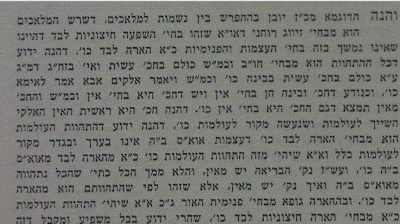AyinBase with R' Paltiel p: 47 3/31/2011 Thursday 25 AdarBase 5771
Page 47 - a few lines below the middle of the page (line starts: vechai...)
Knowing the metzius/object is from the outside. Knowing the mehus/essence is from the inside.
The tzaddik surely appreciates G-dliness, but rather he is one with Him! He knows the essence since he knows it from G-d's perspective.
Metzius is how something is present in contrast to other things. Mehus is not involved with anything else – 'it is what it is – from an insider's perspective'. There's a big world, how can you be who you are? Ha-arah / reflection is involved with world. But mehus is on the level of essence.
This is the difference between hashpaa of sechel vs that of leida (birth).
Mother and father provide the body of the child and He provides the soul. When the birth is not according to His will He still provides the soul, but unwillingly. In proper relations, the third partner, G-d Himself is invited from the outset. Hence one is aware that G-d is unifying the man and woman to draw down a soul.
Quantitative infinity is made up of units and hence there is an outside. For the real qualitative infinity, one and a million are the same. All the pieces are already there. There is no outside. Nothing can be added there. This is metzius in yoshar – one has an independent G-dly creation.
Angels have their function defined. As great as they are, they are functional. For example Gavriel is gevurah. Hence they can only understand chitzoni. Souls are not functional – it is a mehus – they are essential.
Similarly the root of energy that becomes an angel, is also from ohr ein sof. This is to say that even to appreciate an external superficial value one needs a sense of the truth behind it.
Page 47 - a few lines below the middle of the page (line starts: vechai...)
Knowing the metzius/object is from the outside. Knowing the mehus/essence is from the inside.
The tzaddik surely appreciates G-dliness, but rather he is one with Him! He knows the essence since he knows it from G-d's perspective.
Metzius is how something is present in contrast to other things. Mehus is not involved with anything else – 'it is what it is – from an insider's perspective'. There's a big world, how can you be who you are? Ha-arah / reflection is involved with world. But mehus is on the level of essence.
This is the difference between hashpaa of sechel vs that of leida (birth).
Mother and father provide the body of the child and He provides the soul. When the birth is not according to His will He still provides the soul, but unwillingly. In proper relations, the third partner, G-d Himself is invited from the outset. Hence one is aware that G-d is unifying the man and woman to draw down a soul.
Quantitative infinity is made up of units and hence there is an outside. For the real qualitative infinity, one and a million are the same. All the pieces are already there. There is no outside. Nothing can be added there. This is metzius in yoshar – one has an independent G-dly creation.
Angels have their function defined. As great as they are, they are functional. For example Gavriel is gevurah. Hence they can only understand chitzoni. Souls are not functional – it is a mehus – they are essential.
Similarly the root of energy that becomes an angel, is also from ohr ein sof. This is to say that even to appreciate an external superficial value one needs a sense of the truth behind it.

















































